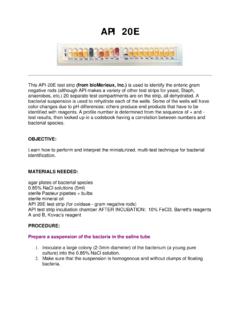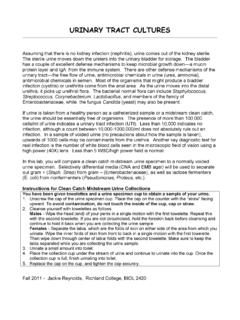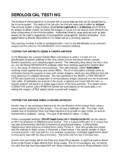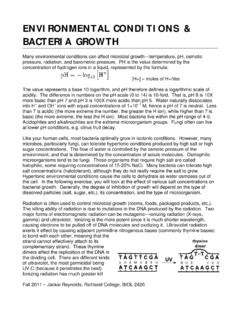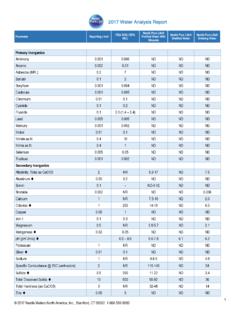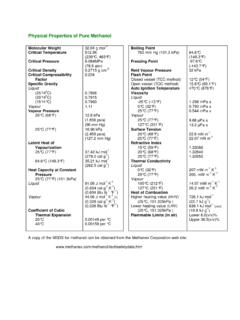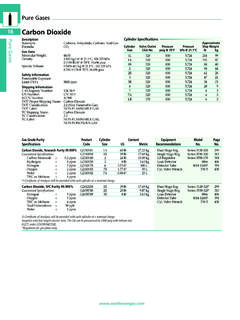Transcription of PURE CULTURE TECHNIQUES
1 pure CULTURE TECHNIQUES . Most specimens (from animal tissue, plant tissue, or environmental samples) will be mixed, with a variety of bacteria (or other microorganisms). A single gram of feces, for example, has over 1010 bacteria and that gram would have over 20 different bacterial species. Particularly in a medical setting, where a patient's body fluid or tissue (skin, blood, spinal fluid, urine) is sent to the microbiology lab for analysis, the specimens will most often be mixed. In order to identify the bacteria and run antibiotic susceptibilities on the causative agent of the infection, the microbiologist must be working with a pure CULTURE of the bacterium. This exercise begins with a mixed CULTURE of bacteria and will end with, hopefully, pure cultures of the 2 bacteria. Luckily, the 2 bacteria being used look different from each other when growing on agar plates. Two different types of agar plate isolation TECHNIQUES will be used---streak and pour.
2 Each method has advantages and disadvantages, and particular uses. The same mixed CULTURE will be used for both methods. Another technique, called the spread plate, is used commonly for counts, as is the pour plate technique. It uses pre-made agar plates, with the fluid inoculum being placed on top of the agar medium. The inoculum is then spread around on the plate with a bent glass rod. That procedure will not be done today. This also gives you a chance to see how agar plates are made. Some of the TSA plates are already made: others will be made by you. This requires that liquefied agar medium (sitting in a water bath) be kept above the solidification temperature. Agar's solidification temperature is 42 degrees C, but its liquefaction temperature is 100 degrees C. When sterilized in an autoclave or boiled, the medium will stay liquid until the temperature gets to 42. C. When that happens, the medium will solidify very fast.
3 If it solidifies on you before you finish making your cultures, it has to be disposed of (if not used yet, it can be placed back in the sterile media racks). REMEMBER. ALWAYS check agar plates carefully to make sure that there are no mold or bacterial contaminants on the plate: if so, discard the plate in the autoclave bag. If you see water running on the agar plate, you can do 2 things: Place the agar plate upside down in the 37C incubator with the top cracked. Get another agar plate. OBJECTIVES: Compare different agar plate isolation TECHNIQUES . Differentiate among various colony morphologies. Fall 2011 Jackie Reynolds, Richland College MATERIALS NEEDED: a CULTURE of E. coli and another bacterium (preferably Serratia, or Staph) mixed together in TSB. water bath at 50 degrees C. per person: 1 TSA plate per table: 3 TSA agar deeps, liquified (in water bath). 3 sterile Petri dishes (into which agar medium will be poured).
4 3 TSA plates THE PROCEDURES: Each student will make 1 streak plate from the mix, incubated at 25 C. Each table will make a set of 3 pour plates from the mix, incubated at 25 C; an extra streak plate from the mix, incubated at 37 C; AND 2 streak plates during the 2nd session. POUR PLATE TECHNIQUE (performed by the table). You will dilute the bacterial sample by transferring loopfuls of the specimen from media tube to media tube, with fewer bacteria ending up in successive tubes. The solidified agar deeps have been boiled and liquefied (agar medium will liquefy at 100 C), then cooled in a water bath. Without cooling the hot agar medium down, your bacterial specimens would be After adding the bacterial samples, the agar is poured into sterile petri dishes and incubated. 1. Find the water baths containing the warm agar media. Leave the tubes in the bath UNTIL you are ready to put your bacterial specimens into the agar tubes, 2.
5 Obtain sterile Petri dishes (make sure that cover stays on) and label as #1, #2, and #3. on the bottom of the dish. 3. Remove 1 tube of liquefied TSA from the water bath and take it to your table. DO. NOT carry all 3 tubes at once: the others will solidify before you can inoculate them. 4. Pick up a loopful of your inoculum from the mixed bacterial CULTURE and transfer it ASEPTICALLY into the first tube of liquefied TSA. 5. Mix this tube #1 by rotating it quickly between your 2 hands: If done adequately, there will be good mixing of the bacteria into the DO NOT invert the tube of agar. 6. From tube #1, aseptically transfer a loopful of the medium aseptically into tube #2. 7. BE SURE THAT YOUR PETRI DISH IS SITTING RIGHT-SIDE UP. Pour the entire contents of tube #1 into the Petri dish marked #1. Open the larger top of the dish RIGHT BEFORE pouring the agar into the dish, and replace the top as soon as finished. Do this quickly.
6 Gently swirl the closed plate about 4-5 times in a large dinner plate-sized circle to spread the agar-bacterial specimen out well in the agar plate. 2. 8. Mix tube #2. From this tube, aseptically transfer a loopful of the medium aseptically into tube #3. Mix the tube well by rotating it between your hands quickly. 9. Pour the entire contents of tube #2 into the bottom of the Petri dish marked #2. Gently swirl the closed plate in large circles o spread the bacterial out well in the agar. 10. Mix tube #3. Pour the entire contents of tube #3 into the bottom of the Petri dish marked #3. Gently swirl the closed plate in large circles to spread the bacterial out well in the agar. 11. Let the 3 plates solidify for at least 15 minutes before incubating. Invert the agar plates when placing them at 25 C. 12. After incubation, check the 3 pour plates for colonies and their features in/on the agar. STREAK PLATE TECHNIQUE: (performed individually and as a table).
7 Subculture a mix of E. coli and Serratia marcescens on a TSA plate, using 2 different streak TECHNIQUES 1ST session: each student streaks a plate from the mix, and the table does an extra plate In this first technique, you will flame the loop between each plate section, thereby diluting the sample as you move from section to section. Remember that you go into the mixed CULTURE tube ONLY ONCE, before the first section. 1. Until you become well-acquainted with this procedure, you might want to draw the 3 sections that you will streak inside of, on the back (bottom of plate containing agar medium). with a sharpie pen. 2. Pick up a loopful of your inoculum from the mixed bacterial CULTURE . Using a sterile agar medium plate, streak a vertical line straight down. While doing this, lift the lid just enough to insert the loop underneath: this will reduce contamination. When streaking the agar, keep the loop horizontal and only streak the surface of the agar: DO NOT DIG INTO THE AGAR.
8 3. Move the loop in a zig-zag pattern across the agar until 1/3 of the plate is covered, finishing the first section. Remember to close the lid on the Petri dish between streakings. 4. Sterilize the loop in the flame and let it cool before continuing to spread the bacteria. You can do this by 1) sticking the hot loop in the agar at the edge of the agar away from the bacteria, or 2) just holding the loop for a few seconds while it cools. 5. Rotate the plate about 90 degrees and spread the bacteria from the first streak into a second area using the same zig-zag spread technique. Lift the lid only enough to effectively streak. 6. Sterilize the loop again. Rotate the plate about 90 degrees and spread the bacteria from the second streak into the 3rd area in the same pattern. Replace the lid. 7. Sterilize the loop again. Invert the plate. Incubate the plate at 25 C. 8. Each table will also make an extra streak plate from the mix, incubating it at 37 C.
9 This plate 3. will be compared to one incubated at 25 C. 2nd session: 1. Check the agar plate CULTURE of the mixed CULTURE for 2 very different colony types. E. coli colonies will be rather transparent and large. Serratia marcescens colonies will be pink/orange, about the same size as E. coli. Also, check your streak technique or get your instructor to do so, for feedback. 2. Your table will make 2 more streak plates to produce 2 pure cultures of the E. coli and Serratia marcescens. Stay away from merging colonies or close colonies. Subculturing in that situation will increase the chances of picking up another mixed CULTURE , consisting of the 2 species that were merged together. ALWAYS pick a well- isolated colony when subculturing. a. Pick a colony of each of the 2 different species of bacteria onto 2 new TSA agar plates, using your best aseptic streak technique. b. Incubate at 25 degrees C. c. Check the plates for purity the next period.
10 INTERPRETATION OF RESULTS: 1. AFTER INCUBATION, check the growth patterns of all plates. Compare the size, shape, and location of colonies on the 3 kinds of plates. Where are the colonies in the pour plates? Why? Why is there so much variation in colony sizes and shapes in the pour plates? Which method is best for accurate counting? Which method is the easiest to do? Which method gives easy access to the colonies---for subculturing to another medium? Which method has the greatest space between the colonies? 2. Compare the streak plates incubated at 25 C and 37 C. Check pigmentation. 3. After the 2nd session, where you made 2 streak plates, check those plates to make sure that you have 2 pure cultures of the 2 bacteria. 4. LABORATORY REPORT SHEET. QUESTIONS: 1. When performing the streak technique, why do you cross over back the 2nd streak section back into the 1st section, and from the 3rd section back across the 2nd section?
